Splinter Cell theme by Kikijin
Download: SplinterCell.p3t
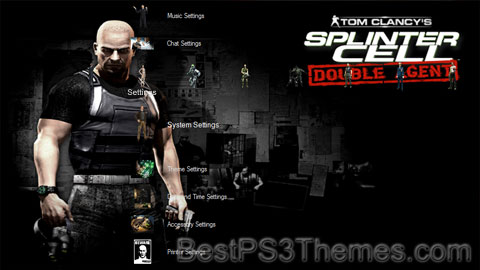
(16 backgrounds)
Redirect to:

The #1 spot for Playstation themes!
Hitman theme by Kikijin
Download: Hitman_4.p3t
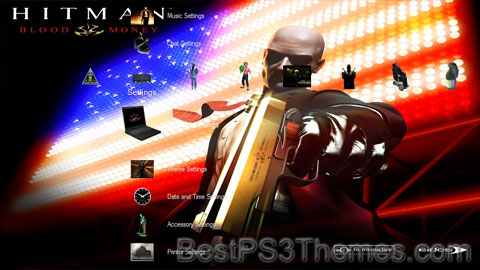
(16 backgrounds)
Redirect to:
This page is a redirect. The following categories are used to track and monitor this redirect:
|
The Sopranos theme by Virya
Download: TheSopranos.p3t
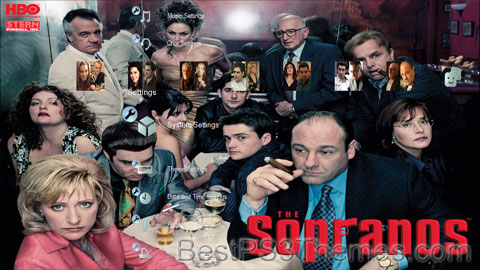
(3 backgrounds)
| The Sopranos | |
|---|---|
 | |
| Genre | |
| Created by | David Chase |
| Starring | |
| Opening theme | "Woke Up This Morning (Chosen One Mix)" by Alabama 3 |
| Ending theme | Various |
| Country of origin | United States |
| Original language | English |
| No. of seasons | 6 |
| No. of episodes | 86 (list of episodes) |
| Production | |
| Executive producers | |
| Production locations | |
| Cinematography | |
| Editors |
|
| Camera setup | Single camera[4] |
| Running time | 43–75 minutes |
| Production companies | |
| Original release | |
| Network | HBO |
| Release | January 10, 1999 – June 10, 2007 |
The Sopranos is an American crime drama television series created by David Chase. The series revolves around Tony Soprano (James Gandolfini), a New Jersey-based Italian-American mobster who struggles to balance his family life with his role as the leader of a criminal organization, which he reluctantly explores during therapy sessions with psychiatrist Jennifer Melfi (Lorraine Bracco). The series also features Tony's various family members, Mafia colleagues, and rivals in prominent roles—most notably his wife Carmela (Edie Falco) and his protégé and distant cousin Christopher Moltisanti (Michael Imperioli).
Having been greenlit in 1997, the series was broadcast on HBO from January 10, 1999, to June 10, 2007, spanning six seasons and 86 episodes. Broadcast syndication followed in the United States and internationally.[5] The Sopranos was produced by HBO, Chase Films, and Brad Grey Television. It was primarily filmed at Silvercup Studios in New York City, with some on-location filming in New Jersey. The executive producers throughout the show's run were Chase, Brad Grey, Robin Green, Mitchell Burgess, Ilene S. Landress, Terence Winter, and Matthew Weiner.
Widely regarded as one of the greatest and most influential television series of all time,[6][7][8][9][10][11] The Sopranos has been credited with kickstarting the Second Golden Age of Television.[12] The series won multiple awards, including Peabody Awards for its first two seasons, 21 Primetime Emmy Awards, and five Golden Globe Awards. It has been the subject of critical analysis, controversy, and parody; it has also spawned books,[13] a video game,[14] soundtrack albums, podcasts, and merchandise.[15] Several members of the show's cast and crew were largely unknown to the public when it began, but have since had successful careers.[16][17][18][19] In 2013, the Writers Guild of America named The Sopranos the best-written TV series of all time,[20] while TV Guide ranked it the best television series of all time.[21] In 2016 and 2022, the series came in first place on the Rolling Stone list of the 100 greatest TV shows of all time.[9][22]
In March 2018, New Line Cinema announced that they had purchased a film detailing the show's background story, set in the 1960s and 1970s during and after the Newark riots. The film, The Many Saints of Newark (2021), was written by Chase and Lawrence Konner and directed by Alan Taylor.[23][24] It starred Gandolfini's son Michael Gandolfini as a young Tony Soprano.[25]
The series follows Tony Soprano, a North Jersey-based Italian-American mobster, who tries to balance his family life with his role as the boss of the Soprano family. Suffering from anxiety-induced panic attacks, he reluctantly engages in therapy sessions with psychiatrist Jennifer Melfi throughout the series. He puts his life at risk on multiple occasions and finds himself at odds with his uncle Junior, his wife Carmela, other Mafia members and non-Mafia criminals, and New York City's Lupertazzi family.
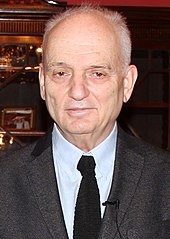
David Chase had worked as a television writer and producer for more than 20 years before creating The Sopranos.[26][27] He had been employed as a staff writer or producer for several television series, including Kolchak: The Night Stalker, Switch, The Rockford Files, I'll Fly Away, and Northern Exposure.[28] He had also co-created the short-lived original series Almost Grown in 1988.[29][30] He made his television directorial debut in 1986 with the "Enough Rope for Two" episode of Alfred Hitchcock Presents. He also directed episodes of Almost Grown and I'll Fly Away in 1988 and 1992, respectively. In 1996, he wrote and directed the television film The Rockford Files: Punishment and Crime. He served as showrunner for I'll Fly Away and Northern Exposure in the 1990s. Chase won his first Emmy Award in 1978 for his work on The Rockford Files (shared with fellow producers) and his second for writing the 1980 television film Off the Minnesota Strip.[31][32] By 1996, he was a coveted showrunner.[33]
I want to tell a story about this particular man. I want to tell the story about the reality of being a mobster—or what I perceive to be the reality of life in organized crime. They aren't shooting each other every day. They sit around eating baked ziti and betting and figuring out who owes who money. Occasionally, violence breaks out—more often than it does in the banking world, perhaps.
—David Chase, creator and showrunner of The Sopranos[34]
The story of The Sopranos was initially conceived as a feature film about "a mobster in therapy having problems with his mother".[29] Chase got some input from his manager Lloyd Braun and decided to adapt it into a television series.[29] He signed a development deal in 1995 with production company Brillstein-Grey and wrote the original pilot script.[27][31][35] He drew heavily from his personal life and his experiences growing up in New Jersey, and has stated that he tried to apply his own "family dynamic to mobsters".[34] For instance, the tumultuous relationship between series protagonist Tony Soprano and his mother Livia is partially based on Chase's relationship with his own mother.[34] He was also in psychotherapy at the time and modeled the character of Jennifer Melfi after his own psychiatrist.[36]
Chase had been fascinated by organized crime and the mafia from an early age, witnessing such people growing up. He also was raised on classic gangster films such as The Public Enemy and the crime series The Untouchables. The series is partly inspired by the Richard Boiardo family, a prominent New Jersey organized crime family when Chase was growing up, and partly on New Jersey's DeCavalcante family.[37] He has mentioned American playwrights Arthur Miller and Tennessee Williams as influences on the show's writing, and Italian director Federico Fellini as an important influence on the show's cinematic style.[33][38][39] The series was named after high school friends of his.[26][36]
I said to myself, this show is about a guy who's turning 40. He's inherited a business from his dad. He's trying to bring it into the modern age. He's got all the responsibilities that go along with that. He's got an overbearing mom that he's still trying to get out from under. Although he loves his wife, he's had an affair. He's got two teenage kids, and he's dealing with the realities of what that is. He's anxious; he's depressed; he starts to see a therapist because he's searching for the meaning of his own life. I thought: the only difference between him and everybody I know is he's the Don of New Jersey.
—Chris Albrecht, president of HBO Original Programming, 1995–2002.[27][40]
Chase and producer Brad Grey pitched The Sopranos to several networks; Fox showed interest but passed on it after Chase presented them the pilot script.[35] They eventually pitched the show to Chris Albrecht, president of HBO Original Programming, who decided to finance a pilot episode[27][31] which was shot in 1997.[41][42] Chase directed it himself. They finished the pilot and showed it to HBO executives, but the show was put on hold for several months.[27]
During this time, Chase, who had experienced frustration for a long period with being unable to break out of the TV genre and into film,[27] considered asking HBO for additional funding to shoot 45 more minutes of footage and release The Sopranos as a feature film. In December 1997, HBO decided to produce the series and ordered 12 more episodes for a 13-episode season.[27][31][43] The show premiered on HBO on January 10, 1999, with the pilot, The Sopranos.
North Jersey prosecutor and municipal judge Robert Baer filed a breach of contract lawsuit against Chase in Trenton, New Jersey federal court, alleging that he helped to create the show. Baer lost the suit, but he won a ruling that a jury should decide how much he should be paid for services as a location scout, researcher, and story consultant. Baer argued that he had introduced Chase to Tony Spirito, a restaurateur and gambler with alleged mob ties, and Thomas Koczur, a homicide detective for the Elizabeth, New Jersey police department. Chase had conducted interviews and tours with both, which strongly inspired some characters, settings, and storylines portrayed in The Sopranos.[44][45] On December 19, 2007, a federal jury found against Baer, dismissing all of his claims.[46]

Many of the actors on The Sopranos are Italian American from the New York metropolitan area, like the characters they portray, and many appeared together in films and television series before joining the cast of The Sopranos. The series has 27 actors in common with the 1990 Martin Scorsese gangster film Goodfellas, including main cast members Lorraine Bracco, Michael Imperioli, and Tony Sirico.[47]
The casting directors were Georgianne Walken and Sheila Jaffe.[48][49] The main cast was put together through a process of auditions and readings. Actors often did not know whether Chase liked their performances or not.[27] Michael Imperioli beat out several actors for the part of Christopher Moltisanti; he said that Chase had "a poker face, so I thought he wasn't into me, and he kept giving me notes and having me try it again, which often is a sign that you're not doing it right." Chase said that he wanted Imperioli because of his performance in Goodfellas.[27]
James Gandolfini was invited to audition for the part of Tony Soprano after casting director Susan Fitzgerald saw a short clip of his performance in the 1993 film True Romance.[27] Lorraine Bracco played the role of mob wife Karen Hill in Goodfellas, and she was originally asked to play the role of Carmela Soprano. She took the role of Dr. Jennifer Melfi instead because she wanted to try something different and felt that the part of the highly educated Dr. Melfi would be more of a challenge for her.[50] Tony Sirico had a criminal history,[51] and he signed on to play Paulie Walnuts so long as his character was not to be a "rat".[52] Sirico had originally auditioned for the role of Uncle Junior with Frank Vincent, but Dominic Chianese landed the role.[53]
Chase was impressed with Steven Van Zandt's humorous appearance and presence after seeing him induct The Rascals into the Rock and Roll Hall of Fame in 1997, and invited him to audition.[54] Van Zandt, a guitarist in Bruce Springsteen's E Street Band, had never acted before. He auditioned for the role of Tony Soprano, but HBO felt that the role should go to an experienced actor, so Chase wrote a new part for him.[50][54] Van Zandt eventually agreed to star on the show as consigliere Silvio Dante, and his real-life spouse Maureen was cast as his on-screen wife Gabriella.[55][56][57]
The cast of the debut season of the series consisted of largely unknown actors, with the exception of Bracco, Chianese, and Nancy Marchand, but many cast members were noted for their acting ability and received mainstream attention for their performances.[27][58] Subsequent seasons saw established actors Joe Pantoliano, Robert Loggia, Steve Buscemi, and Frank Vincent[59] join the starring cast, along with well-known actors in recurring roles such as Peter Bogdanovich, John Heard,[60] Robert Patrick,[61] Peter Riegert,[62] Annabella Sciorra,[59] and David Strathairn.[63]
Numerous well-known actors appeared in one or two episodes, such as Lauren Bacall, Daniel Baldwin, Annette Bening, Polly Bergen, Sandra Bernhard, Paul Dano, Charles S. Dutton,[64] Jon Favreau, Janeane Garofalo, Hal Holbrook, Tim Kang, Elias Koteas, Ben Kingsley, Linda Lavin, Ken Leung,[65] Julianna Margulies, Sydney Pollack, Wilmer Valderrama, Alicia Witt, and Burt Young.[66] Ray Liotta, who was eventually cast as two of the Moltisanti brothers in The Many Saints of Newark film prequel, was approached by Chase at one point to appear in the third or fourth seasons of the show, but the plan didn't work out.[67]
Series creator and executive producer David Chase served as showrunner and head writer for the production of all six seasons of the show. He was deeply involved with the general production of every episode and is noted for being a very controlling, demanding, and specific producer.[26][32] He wrote or co-wrote between two and seven episodes per season and would oversee all the editing, consult with episode directors, give actors character motivation, approve casting choices and set designs, and do extensive but uncredited rewrites of episodes written by others.[58][68][69] Brad Grey served as executive producer alongside Chase but had no creative input on the show.[70] Many members of the creative team behind The Sopranos were handpicked by Chase, some being old friends and colleagues of his; others were selected after interviews conducted by producers of the show.[27][59]
Many of the show's writers had worked in television before joining the writing staff of The Sopranos. The writing team and married couple Robin Green and Mitchell Burgess worked on the series as writers and producers from the first to the fifth season; they had previously worked with Chase on Northern Exposure.[71] Terence Winter joined the writing staff during the production of the second season and served as executive producer from season five onwards. He practiced law for two years before deciding to pursue a career as a screenwriter, and he caught the attention of Chase through writer Frank Renzulli.[33][72]
Matthew Weiner served as staff writer and producer for the show's fifth and sixth seasons. He wrote a script for the series Mad Men in 2000 which was passed on to Chase, who was so impressed that he immediately offered Weiner a job as a writer for The Sopranos.[73] Cast members Michael Imperioli and Toni Kalem portray Christopher Moltisanti and Angie Bonpensiero respectively, and they also wrote episodes for the show. Imperioli wrote five episodes of seasons two through five, and Kalem wrote one episode of season five.[74][75]
Other writers included Frank Renzulli, Todd A. Kessler (co-creator of Damages), writing team Diane Frolov and Andrew Schneider who worked with Chase on Northern Exposure, and Lawrence Konner, who co-created Almost Grown with Chase in 1988. In total, 20 writers or writing teams are credited with writing episodes of The Sopranos. Of these, Tim Van Patten and Maria Laurino receive a single story credit, and eight others are credited with writing a sole episode. The most prolific writers of the series were Chase (30 credited episodes, including story credits), Winter (25 episodes), Green and Burgess (22 episodes), Weiner (12 episodes), and Renzulli (9 episodes).
Many of the directors had previously worked on television series and independent films.[59] The most frequent directors of the series were Tim Van Patten (20 episodes), John Patterson (13 episodes), Allen Coulter (12 episodes), and Alan Taylor (9 episodes), all of whom have a background in television.[59] Recurring cast members Steve Buscemi and Peter Bogdanovich also directed episodes of the series intermittently.[76][77] Chase directed the pilot episode and the series finale.[78] Both episodes were photographed by the show's original director of photography Alik Sakharov, who later alternated episodes with Phil Abraham.[79] The show's photography and directing is noted for its feature film quality.[80][81] This look was achieved by Chase collaborating with Sakharov. "From the pilot, we would sit down with the whole script and break the scenes down into shots. That's what you do with feature films."[79]
The Sopranos is noted for its eclectic music selections and has received considerable critical attention for its effective use of previously recorded songs.[82][83][84][85] Chase personally selected all of the show's music with producer Martin Bruestle and music editor Kathryn Dayak, sometimes also consulting Steven Van Zandt.[82] The music was usually selected once the production and editing of an episode was completed, but on occasion sequences were filmed to match preselected pieces of music.[68]
The show's opening theme is "Woke Up This Morning" (Chosen One Mix), written by, remixed and performed by British band Alabama 3.[86] With few exceptions, a different song plays over the closing credits of each episode.[84] Many songs are repeated multiple times through an e
Heineken theme by Virya
Download: Heineken.p3t
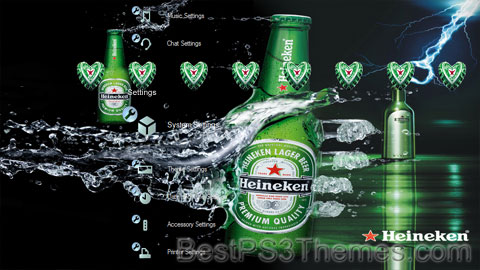
(6 backgrounds)
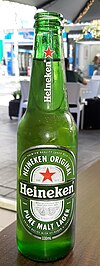 Current export bottle | |
| Type | Beer |
|---|---|
| Manufacturer | Heineken N.V. |
| Country of origin | Netherlands |
| Introduced | 1873[1] |
| Alcohol by volume | 5.0%[2] |
| Colour | 7 EBC |
| Style | Pale lager |
| Original gravity | 1.044–1.048[citation needed] |
| IBU scale | 23[citation needed] |
| Related products | Heineken Oud Bruin Heineken Premium Light Heineken Tarwebok |
| Website | heineken |
Heineken Lager Beer (Dutch: Heineken Pilsener), or simply Heineken (pronounced [ˈɦɛinəkə(n)]), is a Dutch pale lager beer with 5% alcohol by volume produced by the Dutch brewing company Heineken N.V. Heineken beer is sold in a green bottle with a red star.
On 15 February 1864,[citation needed] Gerard Adriaan Heineken (1841–1893)[3] bought De Hooiberg (The Haystack) brewery on the Nieuwezijds Achterburgwal canal in Amsterdam,[4] a popular working class brand founded in 1592. In 1873 after hiring a Dr. Elion (student of Louis Pasteur) to develop Heineken a yeast for Bavarian bottom fermentation, the HBM (Heineken's Bierbrouwerij Maatschappij) was established, and the first Heineken brand beer was brewed. In 1875 Heineken won the Medaille D'Or at the International Maritime Exposition in Paris and it began to be shipped there regularly, after which Heineken sales topped 64,000 hectolitres (1.7 million U.S. gallons), making them the biggest beer exporter to France.[citation needed]



In Heineken's early years, the beer won four awards:
The two awards that are still mentioned on the label are the Medaille d'Or and Diplome d'Honneurs.[8]
In 2013, Heineken joined other alcohol producers as part of a producers' commitments to reducing harmful drinking.[9]
In February 2013, Heineken stopped producing the brown bottles used for the Dutch market in favor of the green color of bottles it already used for exports.[10]
In 2014, Heineken celebrated its 150th anniversary. In 2015, Heineken won the Creative Marketer of the Year Award, becoming the second company to win the award twice.[8]
The original brewery where Gerard Adriaan Heineken first started making Heineken is now the Heineken Experience Museum.[11]
Heineken launched its first non-alcoholic beer in 2017, naming it "Heineken 0.0".[12] It was evaluated positively in terms of taste, with "almost the same taste" as the full-alcohol version, even though Heineken does not claim it to be of the same taste. It was also found to be lower in calories and sugar than a soda.[13]

Since 1975, most Heineken-brand beer has been brewed at their brewery in Zoeterwoude, Netherlands.[1] In 2011, 2.74 billion litres of Heineken-brand beer were produced worldwide, while the total beer production of all breweries fully owned by the Heineken Group over all brands was 16.46 billion litres globally.[14] As of 2022, Heineken is sold in 192 countries.[15] They have also been incorporated with numerous beer brands in countries all over the world, including Mexico, China, Australia and various countries in Africa.

Heineken was the major sponsor of UEFA Champions League and the UEFA Super Cup, UEFA Euro and Rugby World Cup; major sponsorship of Rugby Union had begun in Wales with the Welsh Premier Division competition.
In 1989 "10 Green Bottles Hanging On The Wall" was a popular advert.
Dating back to 1997's Tomorrow Never Dies,[16] Heineken has retained a longstanding relationship with the Bond franchise, consecutively being featured in 8 of their films, including No Time To Die (2021).[17] While it is usually the supporting characters seen drinking Heineken, Bond himself is seen drinking Heineken beer in Skyfall (2012) and Spectre (2015). As a long-term brand investment, Heineken reportedly spent $45 million for its inclusion on Skyfall alone, some $25 million more than Bond actor Daniel Craig's pre-residual salary.[18] As of 2015, it is the brand's largest global marketing platform.[19]
In 2016, Heineken became the Official Beer of the FIA Formula One World Championship starting from the Canadian Grand Prix.[20] During races, Heineken also puts its "When You Drink, Never Drive" advertising campaign all over the race as a campaign to end drunk driving.[21]
In August 2021, Heineken signed a multi-year deal with W Series as the global partner for all-Women single-seater racing series.[22]
Starting with the 2020–24 cycle, Heineken became the sponsors of UEFA Europa League and UEFA Europa Conference League through Heineken 0.0 brands. In 2023, Heineken celebrated its 150th anniversary.
At the end of March 2022, over a month after Russia started its war in Ukraine, Heineken announced that it was leaving Russia (including with its other brands there, like Affligem, Amstel etc.), saying that ownership of the Russian subsidiary was no longer “durable or viable.” But despite this promise Heineken hired more than 240 new staff and launched 61 new products on the Russian market last year[when?], according to investigators from Follow the Money,[23] based on an overview of 2022 by Heineken Russia. The Dutch brewer’s Russian subsidiary looked back on “a turbulent year, with many new growth opportunities.” One of these opportunities being the departure of Coca-Cola and Pepsi from Russia, which Heineken "cynically" used to "enter the non-alcoholic carbonated beverage market". Heineken announced even more investments for 2023, including more modern packaging and new flavors.[24][25][26] However, in August 2023, the company announced it had received necessary approvals to sell its Russian operations to Arnest Group for €1, completing its withdrawal process. The company expects a total loss of $323 million as a result of the deal.[27]
{{cite web}}: CS1 maint: bot: original URL status unknown (link)
{{cite web}}: CS1 maint: archived copy as title (link)